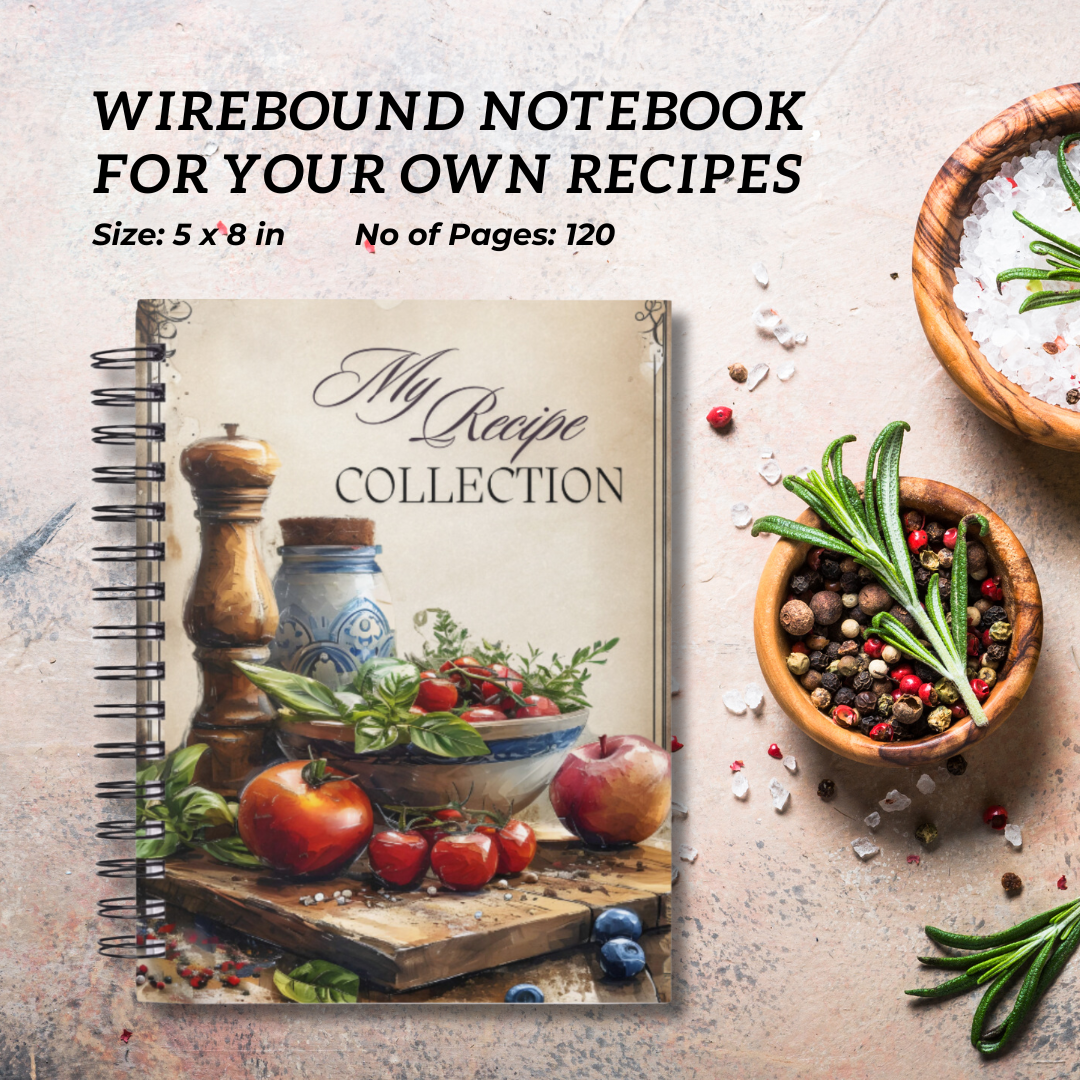Wild
Garlic
England’s
(Not So) Secret Springtime Treasure
You really can’t miss it! If you’ve ever wandered through an ancient English wood in early spring and caught a sudden whiff of something deliciously garlicky in the air, you’ve likely stumbled upon Allium ursinum - better known as wild garlic, or if you’re feeling especially rustic, ramsons or cow leeks. With its delicate white flowers and broad green leaves, wild garlic carpets the forest floor like a well-behaved weed, and for centuries, it’s been sneaking its way into English food with the quiet confidence of a Tudor spy.
I love finding it on walks and - after thirty years of exploring England - we have a list of favourite places we know we can visit in the spring to find wild garlic growing in abundance. From the grounds of majestic Hardwick Hall in Derbyshire to the area surrounding North Leigh Roman Villa in Oxfordshire or a churchyard just outside the pilgrimage centre of Walsingham of Norfolk, we’ve picked wild garlic in all kinds of places. And we keep adding to that list. Just last year, we came across a magnificent patch of wild garlic on a walk around the pretty Northamptonshire village of Harlestone.
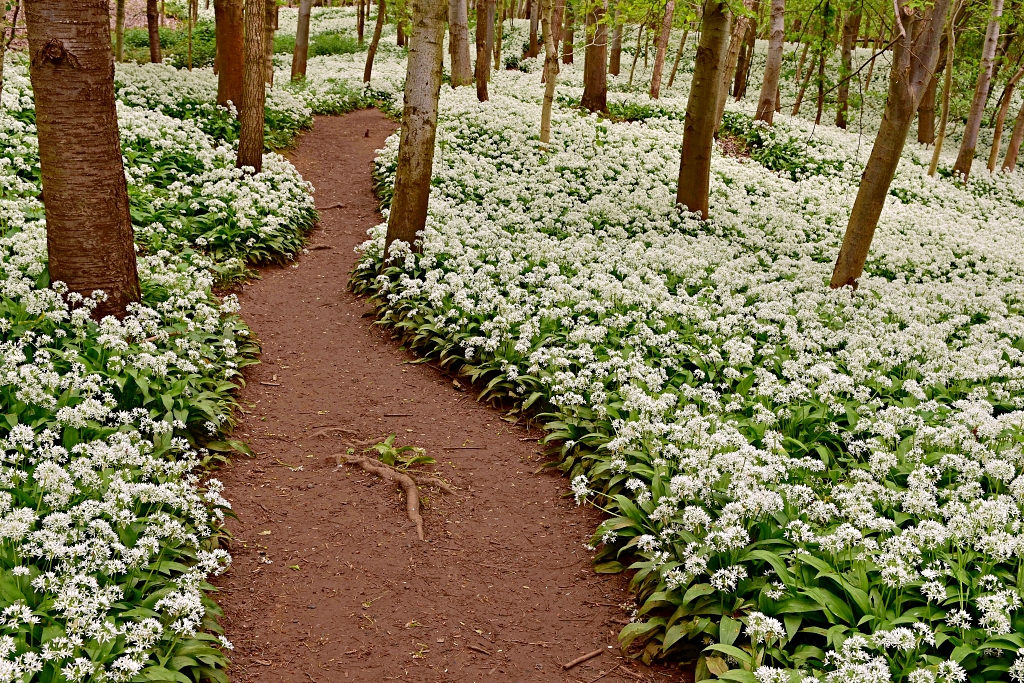 Woodland Path through Wild Garlic near Harlestone in Northamptonshire © essentially-england.com
Woodland Path through Wild Garlic near Harlestone in Northamptonshire © essentially-england.comBut finding a supply of wild garlic rarely requires a long trek. It grows in small patches and pockets all over the country. All you really need to take on your walk is your nose!
The reason wild garlic grows in so many places is that it is no modern foodie fad. Nor does it grow exclusively in England. The onion family, to which wild garlic belongs, is one of the most popular and wide-spread culinary ingredients with very good reason. Can you imagine cooking without onions, spring onions, shallots, garlic, chives, or leeks?
Wild garlic has a pedigree. Long before it found fame in foraged pesto recipes or appeared on the menus of gastropubs from Cornwall to Cumbria, wild garlic was a staple in the workshops of healers and the kitchens of peasants and monks alike. There’s evidence of its use as a healing herb in pre-Roman times, and the Romans, with their love of garlic, wouldn’t have missed out on picking and eating it, either.
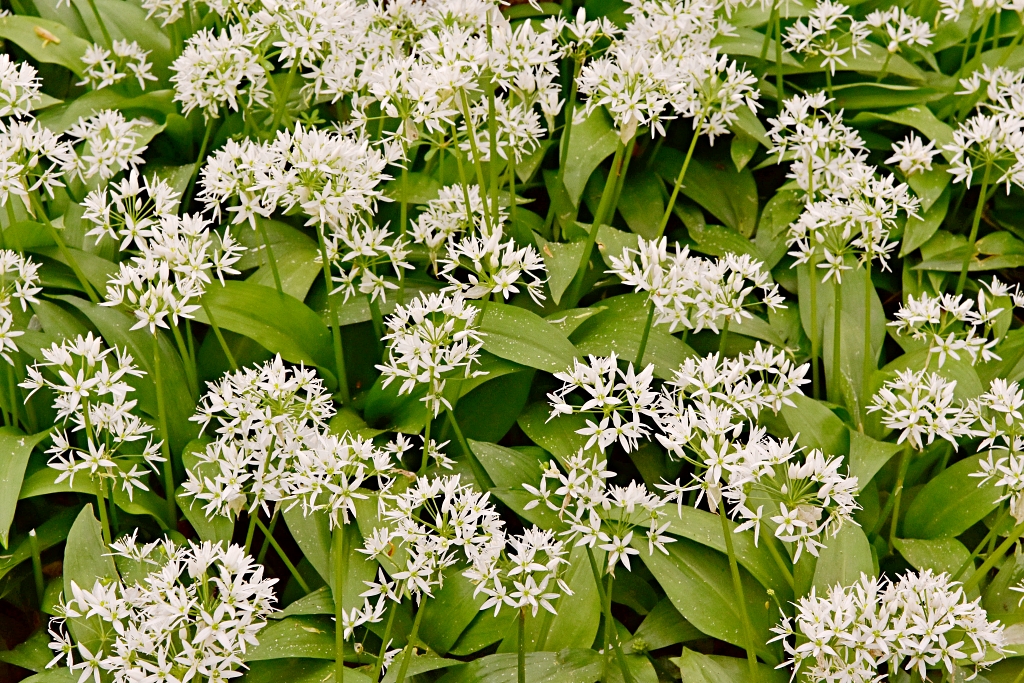 Flowering Wild Garlic © essentially-england.com
Flowering Wild Garlic © essentially-england.com
Uses of Wild
Garlic
Just like the ancients, medieval herbalists prized wild for its cleansing properties, believing it could purify the blood and ward off “evil humours” - a useful skill in the days when bathing was optional, and leeches were considered medicine. They used it to treat all manner of ailments from minor wounds to sore throats, and catarrh to gastric upsets.
Wild garlic was also considered a powerful protection. In some parts of England, it was hung over doorways to keep out witches, and we all know it’s devastating effect upon vampires.
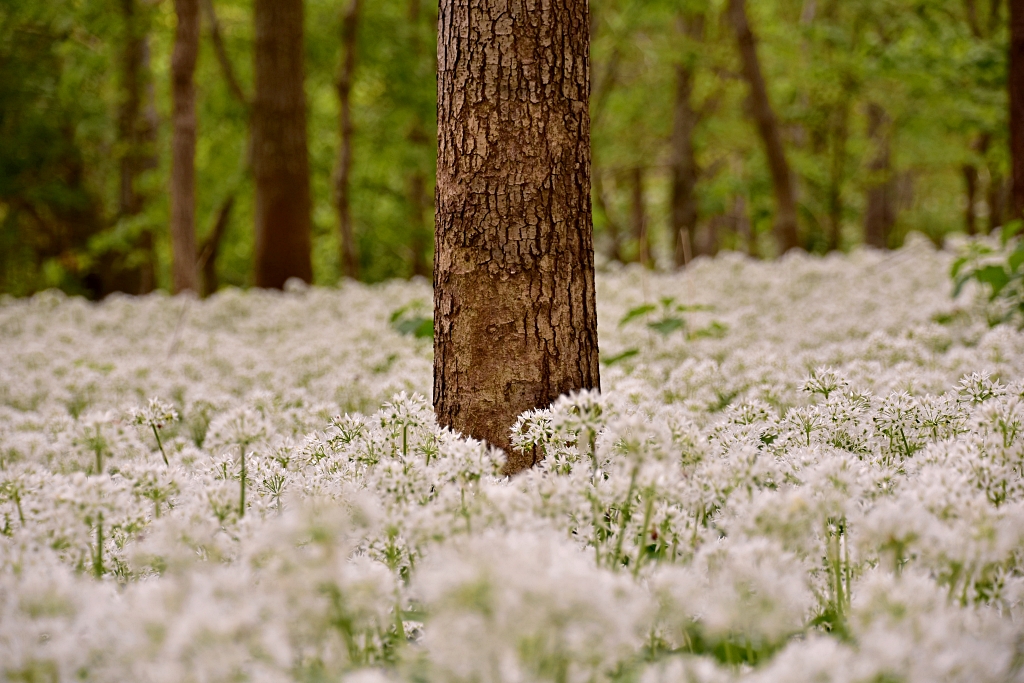 Wild Garlic Carpet in Northamptonshire Woodland © essentially-england.com
Wild Garlic Carpet in Northamptonshire Woodland © essentially-england.com
Using Wild
Garlic in Cooking
The plant’s nickname - bear’s garlic - comes from the old belief that bears, freshly woken from hibernation, would seek it out to cleanse their digestive systems. Even for non-bears, wild garlic brings something invigorating to our spring kitchen.
It’s one of the first new greens available to the cook after a long winter. And while we no longer survive the dark months on diets of cellared root vegetables and salted meat, many of us still experience a desire for fresh and green food come spring.
The other reason I love it so much is that it’s so very seasonal! Cooking with ingredients that are only available for a short time makes for special dinners we remember long after they’ve been eaten, and nature has moved on to provide other treats.
Over the last years, there’s been increased interest in foraged foods, and it’s much more common to find wild garlic on restaurant menus and ingredients lists. But English cooks have always made use of what they could find and forage as well as grow and - for me - the joy of wild garlic lies in being able to add a seasonal and slightly unexpected twist to traditional dinners. There’s rarely a need to measure or weigh. In fact, when it comes to wild garlic, abundance should be the name of the game. After all… you don’t have a lot of time to enjoy it.
So, here’s a list of ideas for what to cook when you find yourself with a bunch of freshly picked wild garlic.
 Wild Garlic Pesto © ManuWe | Getty Images canva.com
Wild Garlic Pesto © ManuWe | Getty Images canva.com
Wild Garlic
Recipes
- Wild Garlic Butter: wash and dry your leaves, then chop them finely and mix into softened butter. Add a little salt to taste if you’ve used unsalted butter. Lovely over a steak or a fillet of steamed fish. Wonderful with new potatoes or spread on hot toast for impromptu garlic bread.
- Sauce for Pasta: For a perfect, minimalist supper melt a knob of butter in a pan, add chopped wild garlic leaves and let them wilt. Add salt to taste, and even a sprinkling of chilli flakes if you like a touch of heat. Stir into just boiled pasta and grate parmesan over the top.
- Wild Garlic and Orange Sauce: This is lovely over fish or chicken. Melt a generous knob of butter, add a large handful of chopped wild garlic, and the grated rind and juice of one orange. Cook, stirring constantly, until the orange juice is nearly gone.
- Garlicky Cheese and Onion Tart: Cheese and onion tart, that mix of cream, eggs, cheese, and meltingly soft onions, is a dish for the gods, and wonderful for brunch, picnic or supper in the garden. A handful of chopped wild garlic leaves adds another dimension. Try it. You won’t be disappointed.
- Wild Garlic Pesto: A paste made from wild garlic leaves, grated parmesan cheese, walnuts, and olive oil. Probably in a ratio of 4:1:1, but please go with what tastes good and add only enough olive oil to create a paste than can be easily spooned over new potatoes, pasta, or a chop.
- Potato Soup with a Twist: I love potato soup in all its forms and wild garlic makes a tasty addition. I add mine - a large handful, finely chopped - near the end of cooking, when I’ve already blitzed my potato soup to velvety softness, and let it soften in the soup. Serve with a swirl of cream and a few toasted pumpkin seeds sprinkled over the top.
- Herby flatbread: Flatbreads are my current obsession, whether made from traditional bread dough or a mix of Greek yoghurt, self-raising flour, and salt. In either case, though, spread out your dough and top it with chopped wild garlic, a sprinkle of coarse salt, and maybe some grated cheese if you want something a little more substantial. Then gather the dough into a ball, turn upside down and roll out, keeping all the filling in the middle. Cook in hot dry frying pan until both sides show gorgeous golden spots. Fab on its own. Better as a side to a stew or a soup. And better still as the base for houmous, guacamole, or a cheese spread with a salad on top.
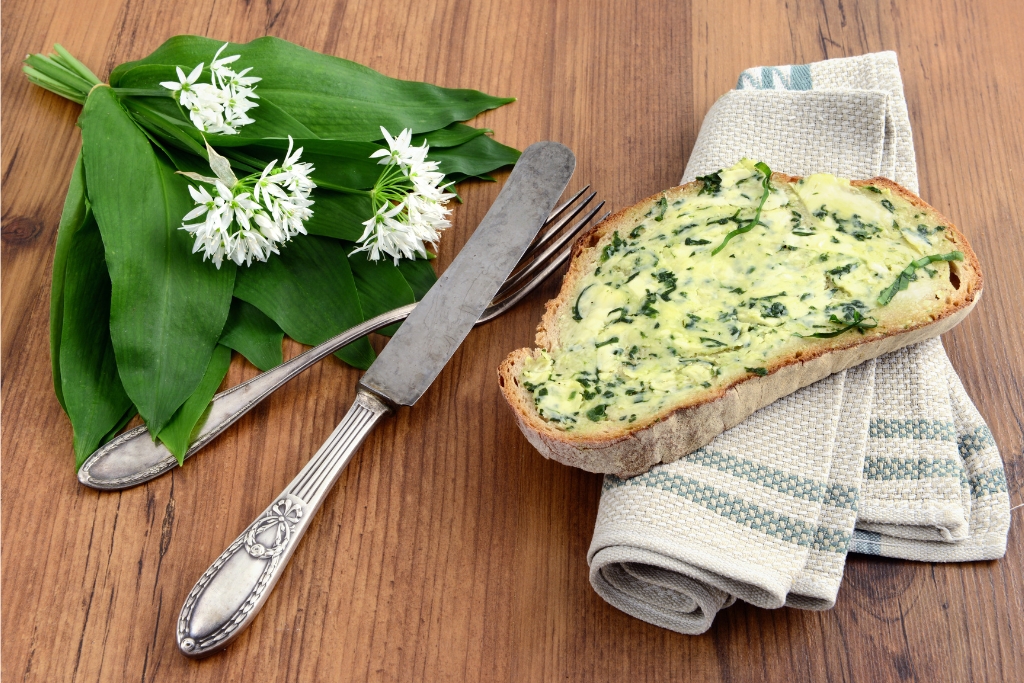 Wild Garlic Butter on Fresh Bread © hsvrs | Getty Images canva.com
Wild Garlic Butter on Fresh Bread © hsvrs | Getty Images canva.com
How to Pick
Wild Garlic
Tempted to gather a few leaves yourself? Wild garlic likes old, shady woodlands with moist ground. The leaves begin to emerge in early March and spread into scented carpets topped with delicate white flowers by Easter. Wild garlic often grows in the same area as bluebells.
Make sure you can identify the plant correctly and never consume anything you’re not sure of. Besides the distinctive garlic scent it has long, smooth-edged, pointed, oval leaves. Each leaf grows on a long stalk from the plant base. You can also recognise wild garlic by its starry white flowers that form clusters on high, single stalks above the carpet of green leaves.
In the UK, picking wild garlic leaves for personal use is permitted so long as you don’t trespass on private land. Digging up the bulbs is illegal.
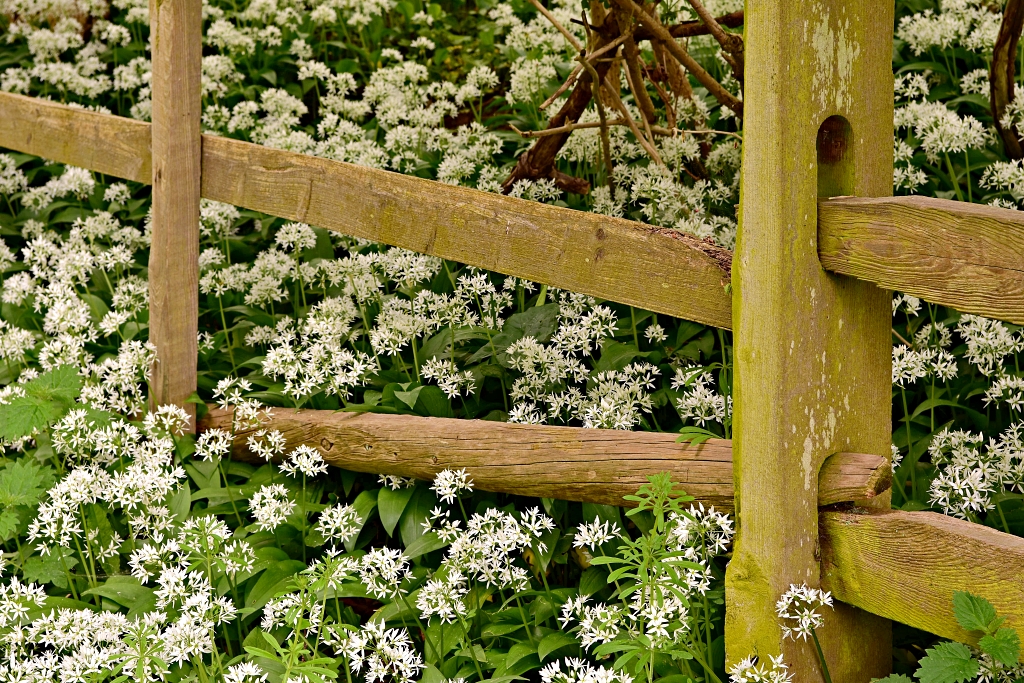 Woodland Wild Garlic © essentially-england.com
Woodland Wild Garlic © essentially-england.com
How do you keep your recipes?
Are you a passionate cook or baker with a treasure trove of old, beloved recipes scattered around your kitchen? Let me help you organise and preserve your culinary heritage in style.
These elegantly designed blank recipe notebooks don't take up much room, but with their user-friendly layout and durable design, they offer plenty of space for your recipe collection. This recipe keeper notebook is your perfect kitchen companion. And filled with their favourite recipes it makes a great gift for children heading to college - or even as a wedding gift.
For more ideas about English Food and recipes return from our Wild Garlic page to the recipes page.
